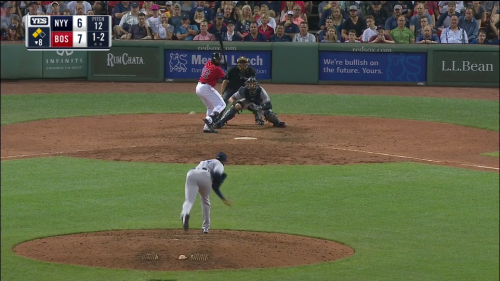BOSTON – The New York Yankees looked to improve upon their four-game winning streak as they met their division rival, the Boston Red Sox, in Fenway Park, on Friday night. Heading into the bottom half of the seventh inning, the Yankees maintained a 6-3 lead, which disappeared due to a terrible bullpen performance. The Red Sox walked away with a 9-6 victory, their third comeback against the Yankees in the second half of the season.
A bigger problem has presented itself to manager Joe Girardi in the month of August. While his Yankees have rattled off some impressive wins, closer Aroldis Chapman has pitched horrendously. Girardi has been persistent in saying that he will stick with his struggling closer, despite allowing seven earned runs in his five appearances this month. On Saturday afternoon, however, he said, “I will use [Chapman] at any point and we do not necessarily have a set closer.”
Overall, there are three major issues that have troubled Chapman as a closer in the month of August: inefficiency, inability to locate slider, and swagger.
INEFFICIENCY IN AUGUST
At first glance, my first thought was to look at Chapman’s strike-to-ball ratio throughout the entirety of the season and here is what I found:
• APRIL: 110/157 FOR STRIKES = 70%
• MAY: 56/88 FOR STRIKES = 63%
• JUNE: 59/79 FOR STRIKES = 75%
• JULY: 149/227 FOR STRIKES = 66%
• AUGUST: 71/113 FOR STRIKES = 63%
In the month of August, Chapman’s strike percentage is down from his season average, but not by much. The most jaw-dropping statistic is in the months of May and June. Chapman made five appearances, just as he has in August, thus far. He threw just 88 pitches in May and only 79 in June. Clearly, he is having a harder time getting batters out and he is throwing more pitches to try and get them out. His inability to command the strike zone right away is getting to him and hitters are becoming more patient against the hard-throwing lefty.

INABILITY TO LOCATE SLIDER:
Chapman is essentially a two-pitch pitcher; he hardly ever throws the changeup that is in his arsenal. So when his slider is not being located where he wants it, hitters are honing in on his fastball. Chapman’s slider is arguably more important than his fastball for the sole reason that it keeps hitters off balance. In Friday’s game, he threw a 1-2 slider to Jackie Bradley Jr. that was ripped into center field, plating two runs for the Red Sox. In Chapman’s first appearance of the season, he demonstrated what his slider is supposed to do as it tailed off the plate in his strikeout of Rays’ shortstop, Brad Miller. Miller was fooled so badly that he took a half-swing at the pitch and made his way back to the dugout.


CHAPMAN’S SWAGGER:
Undoubtedly, Aroldis Chapman is one of the most feared pitchers to face in all of baseball. His best fastball tops out around 103-104 MPH and when he brushes a hitter off the plate, you know the Chapman swag is in full effect. He needs to get his swag back, plain and simple. He isn’t confident on the mound right now and hitters are taking advantage of that. The thing that makes Chapman so effective is how intimidating he is on the mound. Starlin Castro told Anothony McCaron of the New York Daily News back in April, “There are a lot of pitchers who throw hard these days, but, the Yankee second baseman added, “They don’t ‘see’ hard — you can still see the ball well against them.” Castro continued, “He throws 100 and that ball, it looks like 200, especially now, because he’s throwing a changeup and slider, too.” Hitters have a genuine fear when they go up to the plate against Chapman, but not when he is rattled.

Rewind to Brad Miller’s at-bat against Chapman in April. Miller was brushed off the plate by a 101 MPH fastball and then had no chance of hitting his 90 MPH slider tailing away later on in the at-bat. Against Bradley Jr., Chapman should have brushed him off the plate and then finished the lefty hitter off with the slider.
Chapman will be working ferociously to get back to the pitcher he was earlier on in the season and when he does, hitters beware.




